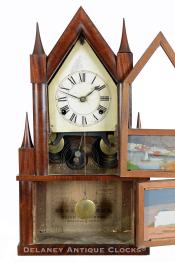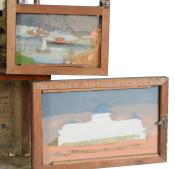Elisha Manross of Bristol, Connecticut. 8-day fusees. Steeple on Steeple. 223125.
This is a unique and vibrant example of a mahogany-cased steeple-on-steeple clock. It boasts eight-day springs and fusee cones, making it a rare find for any antique clock collector.
The case is veneered with mahogany wood and features a clean, warm shellac finish. The color is excellent and enhances the wood’s natural grain patterns. The case features two doors. Both are fitted with glass panels. Two of the panels feature reverse-painted scenes. These are in excellent original condition. The lower glass features a view of our Nation’s Capital. The view depicts the east side of the Capitol building circa 1846. It included innovative interior features and a Bulfinch design of the first low dome covered in copper. The middle panel depicts a harbor scene. Activity surrounds the steam wheel that is anchored in the harbor. Both tablets are colorfully paint-decorated. The upper glass is clear, enabling one to view the painted dial.
The dial is painted on zinc. The time ring features Roman-style hour numerals and a minute ring segmented with dots. This dial is original to this clock and is in excellent condition.
Please keep in mind the movement was photographed before we had a chance to service it. Fully servicing the works will be performed before the clock is delivered. This movement is constructed in brass and is framed with brass strapping. The brass straps are secured with rivets, forming a frame that supports the steel shafts and brass gearing. The works are powered by coil springs. When fully wound, they are designed to run this clock or power it for eight days. The two coil springs are located behind the wooden fusee barrels. These are fronted with brass caps and are supported by a cast iron frame that visually hangs below the movement. The incorporation of fusees helps make this clock a very desirable model. This movement is designed to strike each hour on a wire gong mounted inside the case.
The manufacturer’s label is applied to the inside of the backboard in the lower section of the case. The label reads, “PATENT SPRING EIGHT-DAY / BRASS CLOCKS, / MADE AND SOLD BY / ELISHA MANROSS, / BRISTOL, CONN.” It also lists the directions for how to set it up, operate it, and regulate it. This label is also in excellent condition.
This case measures 23.5 inches tall by approximately 12.75 inches wide.
It was made circa 1846.
Inventory number 223125.
Elisha Manross was born in Bristol, Connecticut, on May 11, 1792. His parents were Elijah and Marhs Manross. Elijah worked as a tinsmith and owned his own shop and general store. Elisha was trained as a wheelwright and a wood turner. In October of 1812, he purchased Joseph Ives's shop in Forestville. He served as a Captain in the War of 1812, commanding a company of one hundred men to guard the coast at Fort Killingly. He was also Captain of the Bristol Artillery Company. He began business by manufacturing wooden parts for other clock makers and formed a partnership in 1837 with Norton—several other partnerships followed with various individuals. In the early 1850s, he set up a shop in Forestville. Here, he introduced the first movements made with jeweled bearings in America. He was a deacon and long a member of the Congregational Church in Bristol. He was an extensive land owner in Forestville and conducted a large clock business, producing more than 20,000 clocks annually. He died September 27, 1856.
Elisha Manross' Greek Revival house, which he built in 1832, still stands today. It is located at 14 (or 12) Washington Street in Bristol.








